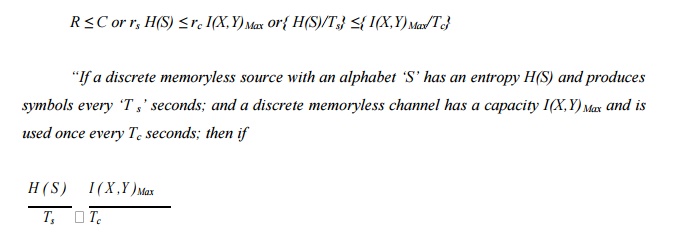Chapter: Analog and Digital Communication
Channel Capacity theorem
Channel
Capacity theorem
Shannon’s
theorem: on channel
capacity(“cod
It
is possible, in principle, to device a means where by a communication system
will transmit information with an arbitrary small probability of error,
provided that the information rate R(=r×I (X,Y),where
r is the symbol rate) isC‘ calledlessthan―chao
capacity‖.
The
technique used to achieve this objective is called coding. To put the matter
more formally, the theorem is split into two parts and we have the following
statements.
Positive
statement:
―Given
a source of M equally likely messages, with M>>1,
which is generating information at a rate R, and a channel with a
capacity C. If R ≤C, then there exists a coding technique
such that the output of the source may be transmitted with a probability of
error of receiving the message that can be made arbitrarily small‖.
This
theorem indicates that for R< C
transmission may be accomplished without error even in the presence of noise.
The situation is analogous to an electric circuit that comprises of only pure
capacitors and pure inductors. In such a circuit there is no loss of energy at
all as the reactors have the property of storing energy rather than dissipating.
Negative
statement:
―Given
the source of M equally likely messages with M>>1,
which is generating information at a rate R and a channel with
capacity C. Then, if R>C, then the probability of error of
receiving the message is close to unity for every set of M transmitted
symbols‖.
This
theorem shows that if the information rate R exceeds a specified
value C, the error probability will increase towards unity as M
increases. Also, in general, increase in the complexity of the coding results
in an increase in the probability of error. Notice that the situation is
analogous to an electric network that is made up of pure resistors. In such a
circuit,
whatever
energy is supplied, it will be dissipated in the form of heat and thus is a
―lossy network‖.
You
can interpret in this way: Information is poured in to your communication
channel. You should receive this without any loss. Situation is similar to
pouring water into a tumbler. Once the tumbler is full, further pouring results
in an over flow. You cannot pour water more than your tumbler can hold. Over
flow is the loss.
Shannon defines ― C‖ the channel capacity of a communication channel a s the maximum value of Transinformation, I(X, Y):

The maximization in Eq
(4.28) is with respect to all possible sets of probabilities that could be assigned
to the input
symbols. Recall the maximum power will be delivered to the
load only when the load and the source are properly matched‘. The device used
for this matching p in a radio receiver, for optimum response, the impedance of
the loud speaker will be matched to the impedance of the output power
amplifier, through an output transformer.
This theorem is
also known as
―The Channel It may be stated in
a different form as below:

There
exists a coding scheme for which the source output can be transmitted over the
channel and be reconstructed with an arbitrarily small probability of error.
The parameter C/Tc is called the critical rate. When this condition
is satisfied with the equality sign, the system is said to be signaling at the
critical rate.

channel and reconstruct
it with an arbitrarily small probability of error
A
communication channel, is more frequently, described by specifying the source
probabilities P(X) & the conditional probabilities P
(Y|X) rather than specifying the JPM. The
CPM,
P (Y|X), is usually referred tonoise characteristicasthe‘
‗of the channel. unless otherwise specified, we shall understand that
the description of the channel, by a matrix or by a
‗Channel diagram‘CPM,P(Y|X).Thus,alwaysindiscretecommunicationrefers to channel with pre-specified noise
characteristics (i.e. with a given transition probability matrix, P
(Y|X)) the rate of information transmission depends on the source that
drives the channel. Then, the maximum rate corresponds to a
proper matching of the source and the channel. This ideal characterization of
the source depends in turn on the transition probability characteristics of the
given channel.
Bandwidth-Efficiency:
Shannon Limit:
In practical channels, the noise power spectral density N0 is generally constant. If Eb is the transmitted energy per bit, then we may express the average transmitted power as:
(C/B)
is the “bandwidth efficiency” of the syste m. If C/B = 1, then it follows that
Eb = N0. This
implies that the signal power equals the noise power. Suppose, B = B0
for which, S = N, then Eq. (5.59) can be
modified as:
That is, "the
maximum signaling rate for a given S is 1.443 bits/sec/Hz in the bandwidth over which the signal power can be spread
without its falling below the noise level”.
Related Topics